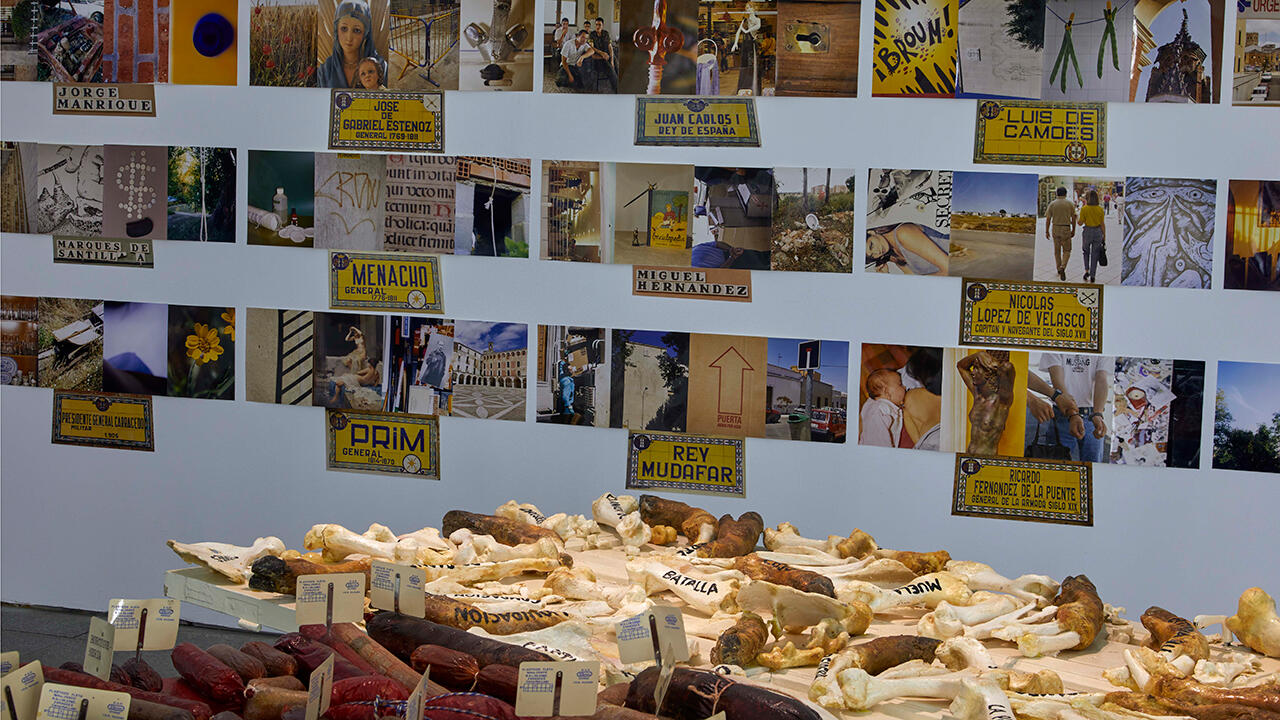What to See During This Year's ARCOmadrid
From an extensive Chiara Fumai retrospective to Lucía Bayón’s denim sculptures, Max Andrews selects the exhibitions not to miss in the Spanish capital
From an extensive Chiara Fumai retrospective to Lucía Bayón’s denim sculptures, Max Andrews selects the exhibitions not to miss in the Spanish capital

Chiara Fumai
La Casa Encendida
4 February – 1 May 2022

In her too brief but incandescent career, Chiara Fumai had many ‘disquieting muses’, as curator Milovan Farronato puts it in the catalogue of ‘Poems I Will Never Release: Chiara Fumai, 2007–2017’. Whether resurrecting the medium Eusapia Palladino or the voice of the leftist terrorist Ulrike Meinhof, Fumai’s installations and magnetic, speech-based live events rallied misrepresented, militant women to take an anarchic stance against patriarchy while inveigling history in a knotty relationship with fiction. The artist’s retrospective at La Casa Encendida includes The Moral Exhibition House (2012), a reconstruction of a performance-based project based on 19th-century pseudoscientific circus shows first presented at documenta 13, as well as a poster announcement for Chiara Fumai Reads Valerie Solanas (2012–13), a performance which plunders the daring writings of Solanas, a radical whose legacy is often reduced to her shooting of Andy Warhol.
Leonor Serrano Rivas
Galería Marta Cervera
17 February – 10 April 2022

35 cm. Courtesy: the artist and Galería Marta Cervera, Madrid
Leonor Serrano Rivas is intrigued by the idea of a kind of theatre without the effects and devices that usually shape theatricality. Alluding to the role of the chorus in Greek dramaturgy, the artist’s recent exhibitions have merged video installation with sculpture and performance through a grammar of sets, props, costumes and backdrops. Rivas often indulges dream-like scenarios and pre-cinematic allegories. ‘Cosmic Dances’ at Galería Marta Cervera includes three suspended loom sculptures from her ‘Arabesque’ series (2019–22). Created in collaboration with artisans in Tangier and at the Royal Tapestry Factory in Madrid, the sculptures are inspired by the performances of Sergei Diaghilev’s Ballets Russes at the Alhambra palace in Granada during World War I.
‘Communicating Vessels: Collection 1881–2021’
Museo Nacional Centro de Arte Reina Sofía
Until further notice

In November 2021, the Museo Reina Sofía unveiled a complete rehang of its permanent collection, including a new ground floor wing of its Sabatini building. Comprising almost 2,000 works – 70 percent of which have not previously been exhibited – the display is neither strictly chronological nor smoothly thematic, proceeding through case studies and geopolitical clusters that at times resemble less a museum of art than a museum of history told through art. Yet the permanent collection thrives in its very sense of impermanence, as the dissidences and turbulences of the avant-gardes spill into new political art, including a room of cardboard placards from feminist and anti-austerity protests. We’ve always lived in complex times, ‘Communicating Vessels’ implores. The fact that the main sponsor of this essentially anti-capitalist, anti-hegemonic exhibition is the fast fashion Inditex group suggests that this vast museum will likewise continue to divulge its own conflicts and contradictions.
Gabriel Alonso & Vica Pacheco
Pradiauto
19 February – May 2022

Pradiauto is an independent space that opened its doors last spring in a former car repair shop in Madrid’s Ciudad Jardín neighbourhood. It is now starting to represent artists, including Gabriel Alonso, one of the founders of the Madrid-based collective the Institute for Postnatural Studies. For the duo exhibition ‘Harp and Throat’, curator Flavia Prestininzi pairs Alonso’s work with a soundscape by Mexican artist Vica Pacheco. Created with recordings of her playing ceramic whistling vessels, the piece evokes Inuit women’s music. Alonso presents a series of new metal and resin sculptures that recall lecterns or the bays and straits found between oceanic island clusters. Author Jorge Carrión compliments the speculative demeanour with a printed litany of literary references. ‘An exhibition is an archipelago of images and vibrations’, reads one, ‘at once a map and a counter-map, what it conceals and what it reveals.’
Lucía Bayón
Intersticio
18 February – 21 May 2022

Last year Lucía Bayón was one of the winners of ‘Generación’, the Fundación Montemadrid’s annual award for young artists working in Spain. For the resulting exhibition, she presented a sculptural constellation derived from resewing denim clothes and shredding and moulding their threads into rigid forms via the use of a Hollander beater, a machine developed in Dutch paper mills in the 17th century. Her show at Intersticio is titled ‘ese entredós’ after a fragment of a verse by Spanish sculptor Pepe Espaliú: an entredós is both a strip of lace joining two fabrics and a piece of furniture usually placed between two windows. Featuring sculptures referencing garment templates and wall reliefs, the show explores Bayón’s pleasure in transitional states via a pulpy agency and cyclical materiality where mashed fibres desiccate into papery thickness and poetic text is tangled into textile.
Andrea Galvani
The Ryder
17 February – 2 April 2022

Andrea Galvani makes art in awe at the limits of human knowledge, the hinterland where scientific complexity becomes bewildering abstraction and research more performative than descriptive. ‘The Theorem of Infinite Sun’, his first solo show in the Spanish capital, includes photographs, light sculptures, video and a live event at the exhibition opening presented in collaboration with Madrid’s Complutense and Autonomous Universities. Titled The Subtleties of Elevated Things (2019–ongoing) the latter saw physics researchers use the gallery walls to pen advanced astrophysical calculations, algorithms and numerical simulations. Meanwhile Graham’s Number (2021) is a neon that expresses an integer so preposterously large that it is impossible to write in conventional scientific notation. Presented on a gold laptop, The End [Action #5] (2015) is a film of a perpetually setting sun, shot from a military aircraft flying against the earth’s rotation.
Main image: Andrea Galvani, The End [Action #5], film still, 2015. Courtesy: the artist and The RYDER Projects, Madrid






















